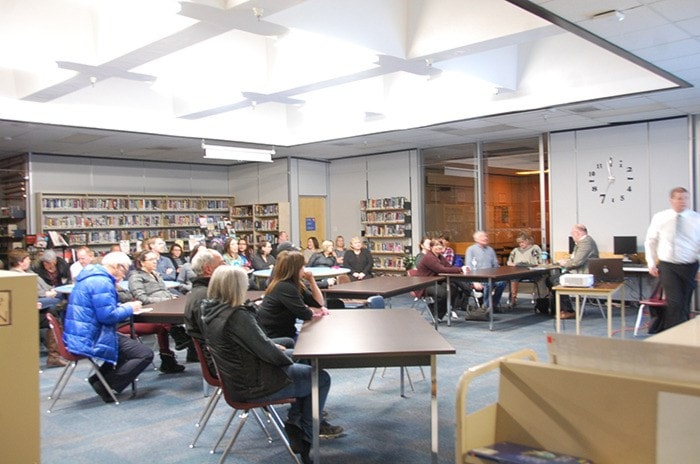At the Houston Secondary School library on Feb. 15, over 45 people attended the public meeting reviewing the facilities ofSchool District 54 (SD54).
A total of $654,140 from the government is given to SD54 annually to manage its nine facilities including HoustonSecondary School (HSS), Twain Sullivan Elementary (TSE), Silverthorne Elementary (SES) schools.
“This has to go directly into facilities. We can’t use it anywhere else. So if we want to fix a wall, a sewer, heating, anything like that, it comes out of this fixed fund,” explained Dave Margerm, secretary treasurer for SD54.
Margerm explained that there are essentially three other pools of fixed funding given by the government. The MinistryCapital Fund for upgrades and projects that the SD54 board applies for. The operational fund where 90 per cent,(approximately$19.5 million) is distributed into salaries, and 10 per cent ($2.8 million) into supplies services.
“If we can not support our facilities, we draw out of the operational fund. If we draw out of here, we loose funds going into educational programming for teachers and class sizes, special education and support, resources, supplies, services,transportation and maintenance,” said Margerm.
The third fixed fund is a surplus that is not sustainable but can be used for either facilities or educational programming. InHouston there are 532 students amongst HSS, TES, and SES. These three schools combined can hold 1000 students, but only 53 per cent of the all the school facilities in Houston are being utilized by student enrollment.
“The optimal percentage for capacity is about 80 per cent to allow for new students and operate trades programs,” said Margerm. Extra space finds a way to get filled. The remaining areas in each school are being use for labs, trades programs,etc. However, the concern is that for each separate facility more money is needed from the limited fixed facilities fund is for their up keep and maintenance. The question is, will use of facilities and funds be more efficiently used if Houston reconfigured and closed a school?
“I don’t want this to get mixed up with what some people worry about as a closure meeting. That is a completely separate process,” said Margerm. “It has to be authorized and recommended by the board. A lot of the time closure processes come from facilities review, this is not that. This is information on the state of facilities, enrollment projections, and capacity figures.”
If the board members were to consider reconfiguration in Houston, these are the facts presented at the meeting on which would be the better school to reduce.
For obvious reason, HSS was not considered because a facility is needed that is equipped to provide secondary education.
Silverthorne Elementary School costs approximately $23,000 more annually to operate. Capital investment has recently been made into TSE to provided a more updated, modern, and efficient structure, including a new boiler and water system that were replaced last year, and previous upgrades to the air management system and roof structure.
Heating, ventilation, and air conditioning, a new boiler, bathrooms would need to be upgraded in the short term for SES at an approximate cost of $680,000.
The proximity benefits of SES provide access to the downtown of Houston, skating arena, curling rink, and pool. TSE is closer to HSS providing shared resources and co-projects.
“The economical and logical choice would be to maintain Twain Sullivan,” stated Margerm.
Approximately $300,000 minimum could be saved with a small elementary closure.
Three options were presented. The first is to leave all three schools open. The second is to consolidate all students into two facilities educating kindergarten to Grade 12. The third is option two and if funding allows to add an additional flexible innovative space.
Questions and concerns about what this might look like and how this will affect teachers and staff were raised.
“Very little reduction,” replied Margerm. “Students follow teachers, and it would not provide good class room learning to have less.” As for what these options would look like, Margerm said that they are not there yet, so a proposal of what that might look like is undetermined.
Reconfiguration has not been decided yet by the SD54 board. A clear time frame was not stated as to when the board would consider reconfiguration however, it was expressed that at this time the board could request more information on to gain more depth on what these proposals might look like without having to accept it.
Next SD54 facilities review will be in November of this year. To keep up to date with the minutes of the SD54 board meetings visit http://www.sd54.bc.ca/index.php/school-board/board-minutes
